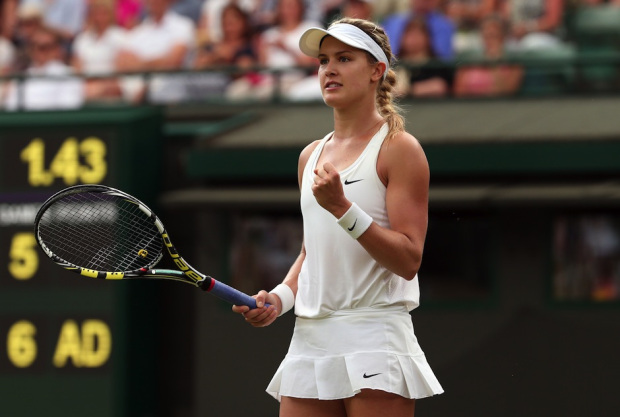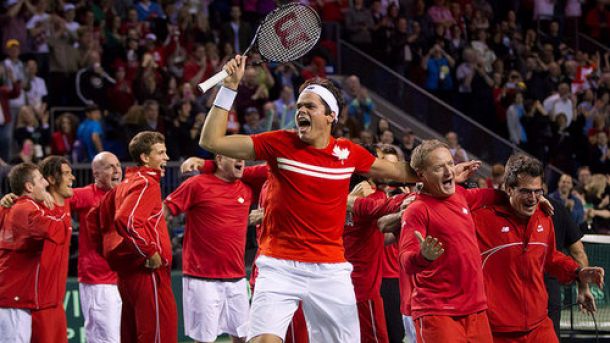When it comes to sports, Canada has always been a nation defined by hockey. Nothing excites the country more than when Canada plays for gold at the Olympics. Even once all their teams have been eliminated from the Stanley Cup Playoffs, Canadians still watch for the love of the game. Tennis has always fallen quite low on the spectrum of popular sports in Canada, well below other sports including baseball, American football, basketball and even soccer. Canada had the odd star, mainly in doubles, which would occasionally fascinate a few die-hard fans. The Canadian Open, now known as the Rogers Cup, is the second oldest tennis tournament in the world and sells out every year. But Canada was never really fascinated by tennis. The best thing to ever happen to tennis in Canada was Roger Federer and Rafael Nadal, but that was hardly exclusive to the great white north.
But in 2011, everything changed. And all it took was a booming serve.
Canada’s transition from ambivalence to tennis-mad started in the second round of the 2011 Australian Open. A little known 20-year-old from Thornhill, Ontario, a suburb immediately north of Toronto, named Milos Raonic of took to the court against twenty-second seed Michael Llodra as the heavy underdog. Riding a gigantic serve, Raonic blasted past the Frenchman and into the third round. There, he was expected to lose as he faced world number ten and recent US Open semifinalist Mikhail Youzhny in the third round. But Raonic made a statement to the tennis world when he defeated the Russian in four sets. All of a sudden, Raonic was into the fourth round of a Grand Slam, becoming the second Canadian man to do so by matching Daniel Nestor’s record-best performance at Wimbledon in 1999.
The days leading up to Raonic’s match with David Ferrer saw tennis hype in Canada reach never before seen levels. It was all over the newspapers, all the TV networks wanted to talk about it and TSN, ESPN’s Canadian equivalent, broke from its regularly scheduled programming to show the match live in the middle of the night in Canada. Even though Raonic lost the match in four sets, the wheels had already been set in motion. Within a few years, tennis would become one of the most popular sports in Canada with its three main stars, Milos Raonic, Eugenie Bouchard, and Vasek Pospisil, reaching celebrity status in their home nation.
There has long been strong feelings for tennis in Canada. There are lots of fans who are diehards and following the tours intensely. Roger Federer and Rafael Nadal would probably rank as two of the most popular non-Canadian, non-hockey playing athletes in the country. The fans in Canada love those two. But the problem that befell tennis in Canada was the lack of homegrown stars for them to support. While it helped that Federer and Nadal transcended both the sport and nationality, it didn’t really help to build the sport in Canada. Canada needed its own stars for young fans to latch onto and support.
The irony is that for a long time, Canada had highly successful tennis players. The problem was, they were either successful at the wrong time or in the wrong discipline. Carling Bassett was a top women’s singles player in the early 1980s, reaching the top ten and reaching the US Open semifinals. The problem for Basset was that the early 1980s was the Martina-Chrissy show and no one cared about anyone other than Navratilova or Evert. In the last twenty-five years, there have been two Canadian superstar doubles players, but neither has managed to reach that level of popularity needed to elevate the sport in Canada. First, there was Grant Connell, who was ranked number one in the 1990s.
He was followed by Daniel Nestor, who is one of the greatest doubles players of all-time. Nester has been ranked number one for over one hundred weeks, has a career Golden Slam and career Golden Masters, and is third on the all-time doubles title list. He’s also been the heart and soul of Canada’s Davis Cup team since the early 1990s. But even despite Nestor’s massive success, tennis’ popularity in Canada didn’t change during his peak years. Why? Because he’s a doubles player. Doubles just doesn’t have the same draw that singles does. If Nestor had been a singles player, he would have been a national hero and canonized a long time ago. But since he plays doubles, he’s often forgotten. For the game to really become popular in Canada, they needed a singles player to succeed.
And that’s exactly what they got in Milos Raonic. Raonic burst onto the scene with a strong run in Melbourne and has never really looked back. Less than a month later, he won his first career title in San Jose. The front page of the Globe and Mail, Canada’s national newspaper, sports section the following day bore the headline “Young Raonic Rockets to Stardom.” A week later, his final against Andy Roddick in Memphis drew record attention and television audiences in Canada. The whole country suffered through his heart-breaking hip injury at Wimbledon that year and eagerly awaited his return at the Davis Cup in September (where, ironically, he lost). Canada reached the World Group of the Davis Cup for the first time in eight years in 2012 and the tie was played in Vancouver against France. They hype machines were going across the country and most sports fan were glued to the TV hoping to see Milos take down the French. Unfortunately, Canada lost the tie, but the nation had been united by tennis in a way that it never had been before. The whole country took pride in his victory over Andy Murray in Barcelona in 2012.
As Raonic continues to succeed, the nation’s love for tennis increases regularly. He can’t play a match without there being three news articles written by each sports agency in the country reporting on it. He can’t sneeze without the whole country knowing. That’s because the whole country wants to know. He’s become the symbol of Canadian tennis. His run to the 2013 Rogers Cup final in Montreal was one of the proudest moments in Canadian tennis history and the fans carried him through that tournament. The Canadian fans became famous after that tournament for their diehard devotion to their hero. And that devotion has not wavered since, especially since Raonic is now consistently reaching the quarter and semifinals of Masters 1000s and Grand Slams. His success has transformed Canada into a nation obsessed with the game.
Photo by Stan Behal, QMI
Raonic’s success opened the floodgates both for the popularity of the sport in Canada, but also for his fellow Canadian tennis players to garner some much deserved attention. It then becomes a cycle as these new players earn more fans which makes the game more popular and gives more attention to less famous players. And so on and so forth. One prime example is Vasek Pospisil. Pospisil is slightly older than Raonic and had been kicking around as a decent player for a couple of years when Raonic had his breakout. The effects of Raonic’s and Canadian tennis’ new-found popularity had a quick effect on Pospisil. In September 2011, Canada found itself in the Davis Cup World Group playoffs against Israel. Because of Raonic, the tie received a lot of attention in the media. When Raonic lost his opening match, all eyes shifted to Pospisil. He rose to the occasion, winning the doubles match with Daniel Nestor as well as both his singles rubbers, including the deciding rubber, to send Canada to the world group. Pospisil was an instant hero in Canada and has never really exited the limelight since.
While he’s failed to make a huge, consistent impression on the ATP World Tour, he’s one of the premier “also-rans” of the ATP World Tour. And Canadians love him. Many Canadian tennis fans actually believe that Pospisil is a better, more complete player than Raonic. The highlight of his singles career could not have come at a better moment: on home soil at the 2013 Rogers Cup in Montreal. Pospisil went on a Cinderella run, which included top-twenty wins over John Isner and Tomas Berdych (a top ten player), to the semifinals where he set an All-Canadian clash with Raonic. The match was an epic, requiring a deciding set tiebreak. While Pospisil lost the match, expectations were high for him, and have remained so. Since that run in Montreal, the saying “Anything is Pospisil” can be heard commonly across Canada.
While Pospisil has not had the singles results he or the country would like, he has managed something that several Canadian legends have not: become popular for doubles play. As part of the “Pospisock,” the nickname for his doubles partnership with Jack Sock, Pospisil has become one of the most popular doubles players in the world. And Canadians are very proud to call him their own. The Pospisocks rocketed to stardom when the shocked the world at Wimbledon last year, taking out the top two teams in the world on route to the title (including the “unbeatable” Bryan brothers). Daniel Nestor won eight grand slam doubles titles (so far) in his career with little to no fanfare.
When Pospisil won the title, the country went nuts. Combined with the deep runs in singles by Raonic and Bouchard, it was largely claimed, especially in Canada, that the Canadians had won Wimbledon, spearheaded by Vasek Pospisil. And Pospisil has continued to succeed in doubles. He’s brought home a few titles, including a Masters 1000 title, and has been ranked as high as second in the world in doubles. And what’s amazing is that he’s getting the attention that Nestor never has. Pospisil has made doubles cool. Or at least he’s made Canadians care. It probably helps that he’s young and has an outgoing personality. Even though he may not be the most successful Canadian, Vasek Pospisil is one of the more beloved and is a big reason why Canadians are caring more and more about tennis.
Photo: Steve Tignor, tennis.com
Canada’s recent success in tennis is hardly exclusive to the men. In fact, while Raonic and Pospisil have been overall more successful, they are hardly Canada’s most famous or popular tennis players. That title belongs to the twenty-one year old bombshell from Montreal, Eugenie Bouchard. In 2012, Bouchard became the first Canadian to win a Grand Slam singles title at the junior level, winning Wimbledon. This pegged her as one of the top up-and-coming players on the WTA Tour. Normally, an up-and-coming Canadian tennis player would receive no attention. But since the media was already beginning to focus more and more on Canadian tennis (when Bouchard won Wimbledon, her title along with that of Filip Peliwo, who won the boys singles, received a full two-page spread in the Globe and Mail), her results were followed more closely. When she broke out at the 2014 Australian Open, the country went ballistic. Never so quickly in the history of Canadian tennis, or almost all of Canadian sport for that matter, was an athlete so quickly adopted as a national icon. Bouchard swiftly become the most beloved female athlete in Canada, and arguably the most popular Canadian athlete period (including hockey players).
As she continued to go deep in slams, including the French Open semis and Wimbledon final, her star continued to rise. Everyone wanted a piece of her. Her results and movements were constantly being reported in the news, while you couldn’t walk down the street in Toronto without seeing her face on a poster. That’s still the case almost a year after her last good result at a major. When TSN did their annual “year in review” episode, Bouchard’s success was the number two story of the year (behind Canada’s second consecutive Olympic double gold in ice hockey). Genie was a household name in Canada. Canadians who weren’t even sports fans were tuning into her matches. She transcended the sport in Canada. Bouchard’s collapse in 2015 is actually almost evidence of her popularity. It’s gotten so much attention because Genie is so popular in Canada and fans are so heartbroken that she’s losing. If she wasn’t so popular, if tennis wasn’t as important to Canadians as it has become, her struggles wouldn’t be quite as well documented. But while it sucks for Bouchard, it’s evidence of the positive effect she has had on Canadians feelings towards tennis.

Photo: Andrew Yates, AFP
When Canadians are doing well in tennis at the moment, there is very little more important in Canada. There are a handful examples of this. Firstly, there was Canada’s Davis Cup run in 2013. When Canada upset Spain in the opening round, the country went wild. It was all over the news for days after. When they cruised by Italy in the next round, you could feel the excitement in the air. And even though they lost to Serbia 3-2 in the semis, the support at home for the team could only be beaten the support for the Olympic hockey team. Never in Canadian history had there been more excitement at a tournament than the 2013 Rogers Cup, when Pospisil and Raonic both blasted through difficult draws to face-off in the semifinals. That match actually out-shone the second semi-final which was an epic between Rafael Nadal and Novak Djokovic. Even though the Nadal-Djokovic match was closer in score and Nadal was in the midst of one of the greatest summer hard court seasons ever, what most Canadians remember from the 2013 Rogers Cup was the Raonic-Pospisil match. Just under a year later, Raonic and Pospisil would again make the country proud, this time by invading the United States capital and facing off in the first ever all-Canadian final on the ATP World Tour at the 500 event in Washington D.C. Pospisil was particularly impressive, winning his quarterfinal and semifinal on the same day before taking on Raonic in the final the next day.
The match was talked about for weeks afterwards, even though it was a fairly one-sided match in favour of Raonic. And then of course 2014 took Canadian tennis to a new level in slams. Bouchard’s run to three straight slam semifinals and the Wimbledon final took the country by storm. Raonic blasted into his first grand slam quarter-final at the French Open, reached the semi-finals of Wimbledon, beat Federer in Paris-Bercy and qualified for the ATP World Tour Finals. Pospisil won Wimbledon in doubles. Wimbledon was the high point in Canadian tennis history, with all three big players reaching at least the semi-finals, Bouchard reaching the singles final and Pospisil winning the doubles title. Raonic and Bouchard’s achievements were firsts for Canadian singles players. Since then, TSN regularly shows ads for tennis tournaments showing highlights of all three and Nestor. Some have even claimed that tennis is becoming Canada’s game. There are few athletes in Canada being promoted more than Raonic, Pospisil and Bouchard. It’s almost impossible to watch TV during the season in Canada without seeing their faces on your screen.
For the first time ever, Canadians care about tennis. And it’s all thanks to the big three of Raonic, Pospisil and Bouchard. For the first time, Canadians have someone of their own to root for. Canadians want to know how their stars are doing. Just look at TSN’s coverage of the Grand Slams. You can always Canadians’ matches on TSN.ca and TSN will interrupt the feeds they’re borrowing from ESPN to show Canadians playing, even if it’s two low-ranked players on a side-court. If one is Canadian, it could take priority over some top players. TSN has even started sending their own reporters to slams to focus on Canadian players because there is now an audience watching at home in Canada expecting coverage and reporting on Canadians. This is because Canada is actually good at tennis now. The more Milos, Vasek and Genie succeed, the more Canadians care about the sport. Rogers Cup and home Davis Cup ties have been likened to rock concerts because of the enthusiasm of the crowd. There are always large TV audiences watching one of them play. Ten years ago, Canadians didn’t care about tennis unless it was Federer or Nadal. Now, they live and die by their favourite sons and daughters.






































